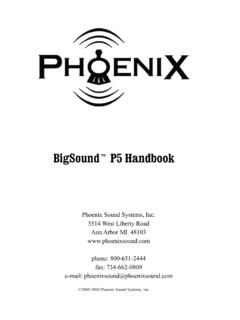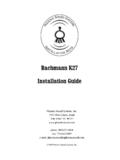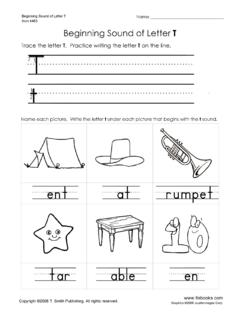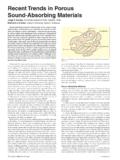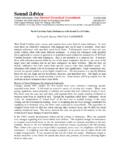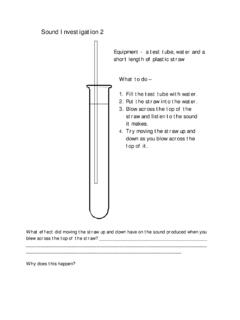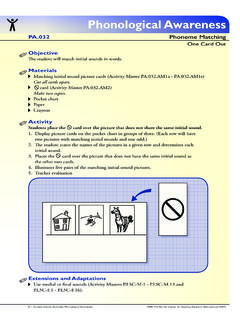Transcription of BigSound P8 Handbook - Phoenix Sound
1 BigSound P8 HandbookPhoenix Sound Systems, West Liberty RoadAnn Arbor MI : 734-662-6405fax: 734-662-0809e-mail: 2010-2014 Phoenix Sound Systems, of Sound Board & from the Pin Out Basic Bench Switch Speed Trigger Function Variables (DCC CV)..9 Standard Sounds and Sounds and Jack A: Wiring Airwire 900 ..18 RCS Railinx 3 Railinx 6 B: P5T Auxiliary Input Input Board (P5T) C: The Computer 2014- 2 -IntroductionDear Model Railroading Friends,Thank you for choosing Phoenix Sound Systems to fill your railroad with Sound . The P8 board is designed for applications with a constant power source - DCC, constant track power, on board batteries or stationary P8 system, like all of our systems since the 2K2, can be loaded and customized using a PC.
2 You will need to upgrade your PC software to version and ROM library to version R7 or newer in order to load and save P8 compatible know you re eager to do some listening, so continue through the initial checkout. The Phoenix BigSound P8 board comes with high input voltage tolerances to keep pace with todays larger trains and bigger power supplies. The board is highly protected against improper wiring and over-voltage gremlins. However, if you notice static electric sparks when you touch things you should ground yourself by touching something conductive before handling your board. Also be careful not to lay the board on metal surfaces or model parts when powered. Basic electrical component handling care is always a good idea. Happy Listening!November 2014- 3 -Getting AcquaintedOne of the ideas behind the P8 system is to tailor the system to your needs to avoid unnecessary expense.
3 The P8 Basic system includes the Sound board (pictured below) and basic connectors. We also offer the P8 as a kit which includes the Sound board with a speaker and any connectors appropriate to the are 3 connectors on the P8 board. The chart on the following page shows the pin out for each. This chart also details the length and coloring of the wire leads if you order the generic Sound Board & ConnectorsDifferences from the P5 The P8 uses the same connectors as the P5. However it is not directly plug in compatible. Plugging a P8 into a P5 hookup will not cause damage, it just won't work quite main difference is that the P8 does not combine speed and power on pins C1:1 and C1:2 as the P5 does. Other changes were to move the expansion signal connections (for the P5T) to C3, as it is on the PB9, and redefine those pins on C2 as trigger the chart on the next page for complete details of the P8 pin 2014- 4 -Connector Pin Out ChartConnector: PinPurposeColorTerminationC1:1 PowerGreenBareC1:2 PowerGreenBareC1:3 SpeakerBrownSPOX-3C1:4 Ground- C1:5 SpeakerBrownSPOX-3C1:6 Speed (DCC or M+)OrangeBareC1:7 Speed (DCC or M-)GrayBareC2:1 Trigger GroundBlueBare*C2:2 Trigger1 OrangeBare*C2:3 Trigger 2 WhiteBare*C2:4 Trigger 3 BrownBare*C2:5 Trigger 4 YellowBare*C2:6 Trigger 5 VioletBare*C2:7+5V ExpansionRedBare*C2:8 GroundBlackVolume SwitchC2:9 Volume LevelYellowVolume SwitchC2:10 Volume +5 VRedVolume SwitchC3:1 GroundBlackJackC3:2 CAN DataWhite C3.
4 3 Serial DataYellowJackC3:4+5 VRedJack These connections can terminate in either nothing, bare wire or reed switches, depending upon the type of engine the unit is ordered 2014- 5 -Initial CheckoutThe Basic Bench TestEach system is tested before shipping but we recommend that you hook things up on your workbench, play with the system and get comfortable with the components before speaker and power supply connect to C1. The speaker connects to the speaker jack (brown wires). Hook your bench power supply to the power wires and the speed wires. A power source of any polarity is acceptable. The maximum peak input voltage is 30 volts. If you are using a volume switch plug it into C2. This connector can only be inserted in one direction, so if you wired your own following the pin out chart on page 5 or are using one we supplied, it should work correctly.
5 When the power rises above 9 volts you should hear Sound . If you are using our volume switch, raise and lower the volume. Steam systems will play idle sounds; diesel units will rev YOU ONLY CONNECT POWER TO C1:1 & C1:2 AND DO NOT FEED ANYTHING TO THE SPEED PINS (C1:6, C1:7) YOU WILL NOT GET ANY Sound . PLEASE KEEP THIS IN MIND AS YOU TEST AND INSTALL THE 2014- 6 -Reed Switch Speed CheckoutSTEAM UNITS ARE FACTORY SET FOR SPEED FROM TRIGGERS. DIESELS ARE SET FOR SPEED FROM INPUTS C1:6 & C1:7 (MOTOR VOLTAGE / DCC) BY you will be using a reed switch and magnets to sense speed, you may wish to hook them up and experiment with the magnets to get an idea of the sensitivity of the reed switches. This will help you decide how to mount them in the locomotive or car.
6 Whenever the speed trigger (C2:2) is connected to the trigger ground (C2:1) the system sees motion. The first closure should play the start toots and the starting CheckoutIf you will be using reed switches and track magnets or other triggers, such as non-DCC remote control receiver outputs or Hall Effect devices, to trigger sounds you may wish to test them out before final installation. If you will be using reed switches you can use the same methods as for the Speed Reed above. If you are using RC outputs, connect them as per the appropriate wiring diagram and test their response for range and reliability. The chart below shows the default trigger terminal assignments. Default Trigger AssignmentsC2 PinDieselSteam1 Trigger GroundTrigger Ground2 NoneChuff3 Manual HornWhistle4 BellBell5 Defect DetectorsBlowdown6 Station AnnouncementStation Announcement7+5V (100mA) for Hall Effect Device or similarNovember 2014- 7 -DCCDCC CheckoutConnect both the Power and Speed wire sets to the track pick ups of your locomotive.
7 The Sound board default address is 3. Select 3 on your DCC controller. Turn the speed up and down. Sounds should play in coordination with the changing speed commands. Test the function buttons. The default function button assignments are in the chart Function DefaultsAddress:3 FunctionDieselSteamF1 BellBellF2 Manual HornManual WhistleF3 Coupler ClankCoupler ClankF4 Crossing HornCrossing WhistleF5 Defect DetectorsCoal LoadingF6 Rev UpWater FillF7 Volume UpVolume UpF8 Volume DownVolume DownF9 Rev DownBlow DownF10 Station AnnouncementStation AnnouncementF11 Brake Screech<none>F12 ShutdownShutdownSTEAM LOCOMOTIVES WILL REMAIN IN IDLE UNLESS SET FOR SPEED FROM DCC RATHER THAN SPEED FROM TRIGGERS. SEE THE SECTION ON DCC CVS TO CONFIGURE STEAM TO USE THE DCC THROTTLE FOR SPEED RATHER THAN TRIGGERS SUCH AS A REED 2014- 8 -Control Variables (DCC CV)P8 firmware supports the following Control Variables.
8 These can be programmed on the program track or using service mode MODE ( PROGRAMMING ON THE MAIN ) IS NOT RECOMMENDED FOR ADDRESS CHANGE Value1 Short Address317 Long Address018 Long Address3490 = Speed from Triggers; 0, speed from DCC050 The DCC Value where motion DCC Rate (Speed vs. Throttle)10052 Seconds to simulate DCC if DCC signal is = Forever053 Seconds in idle before = Never shutdown0 November 2014- 9 -Standard Sounds and EffectsMost sounds play automatically based on train speed. Many sounds can also be set to play using designated trigger inputs. The following section describes the standard Sound system configuration. All SystemsWhistle/Horn: Toots when starting (2 forward, 3 reverse) and stopping (one toot). Crossing whistle sequence plays when you reach the Whistle/Horn play speed.
9 You must slow down to at least 75% of the play speed in order to have it play again when you speed back up. Bell: Plays when you first start moving and just before stopping. You must reach twice the bell stopping speed in order to replay the bell when stopping. The bell will not replay unless 35 seconds have elapsed since the last time it Clank: Plays when you come to a stop in reverse; will not replay until you go forward and back up again. Brake Screech: Plays just before SystemsAir Pop: Plays periodically during Release: Plays as the engine starts SystemsBlow Down: A longer and more vigorous steam release that clears the flues. Plays as you slow Release: Plays after you come to a : Basically runs all the time but the engineer will shut it down if the engine sits in idle for awhile.
10 Comes back on when voltage approaches the start voltage. Air-Pump: Plays in idle to maintain air 2: A sustained compressor run that restores air pressure after it s been clank: Plays at slow speedHiss: Plays at low speed, clears the cylinders of excess Shoveling: Plays periodically while engine sits at idle. Not enabled on wood and oil burning 2014- 10 -Triggered Sounds and EffectsThe P8 board has five trigger inputs. The Auxiliary Input Board [P5T] allows you to trigger additional sounds using reed switches or outputs from remote control receivers. The following section describes sounds which may be assigned to triggers or DCC functions. Of course, any Sound can be assigned to a trigger. See the tables on pages 7 and 22 for factory default trigger and DCC Function SystemsTunnel Fade: This trigger causes the volume to fade down to a lower setting.

